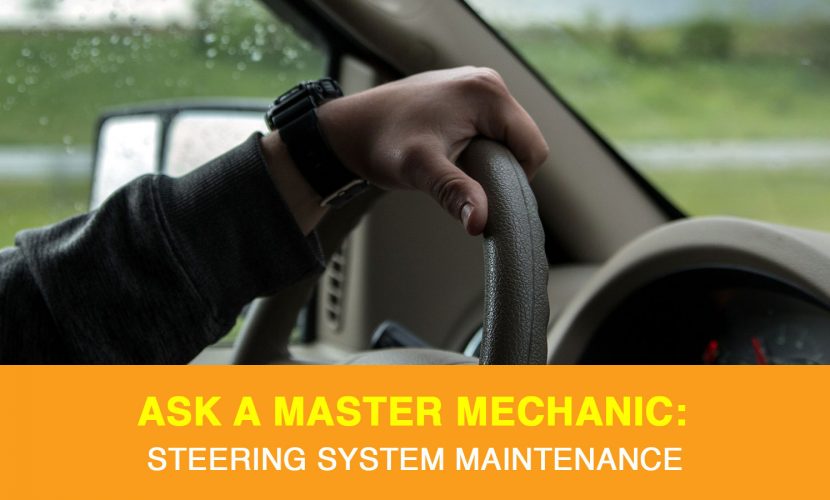
Ask A Master Mechanic: Steering System Maintenance
You don’t need to be a Master Mechanic to understand that steering is a pretty integral part of driving. By definition, power steering is a system that reduces the steering effort the driver needs to apply by using a power source to assist in turning the wheels. So, how do you keep your steering system operating smoothly?
Your steering system has three major components that are complex and require regular maintenance. The three major components for your steering system include:
- The steering wheel and attached shaft in the steering column. These connect to the steering gear.
- The steering gear that is responsible for changing the rotary motion of the steering wheel to linear motion
- The steering linkage that carries the linear motion to the steering-knuckle arms
Along with these three major components, your power steering system may also contains a power steering pump, steering gear, linkages, bearings, drive belts, valves, seals and hoses. Yes, it’s pretty complicated stuff.
If you think there’s an issue with your steering, please call us immediately. Our Master Mechanics can help. While many issues may be quick to fix, we don’t advise working on your steering system yourself.
If you feel your steering is stiff, you might simply need new power steering fluid. Power steering fluid provides hydraulic pressure and lubricates your power steering system. When your power steering fluid becomes oxidized, its ability to protect components and transfer pressure is decreased. It is important that you completely flush the old fluid before replacing it. Like replacing your oil, this will ensure all contaminants are removed and that your steering system is performing at its best.
Most power steering systems use a belt driven pump that provides hydraulic pressure to the system. There is a rotary-vane pump which is driven by your vehicle’s engine that creates this hydraulic pressure.
If you notice any screeching or squealing noises when accelerating, you might be experiencing low belt tension, contamination or belt vibration. Inspecting your belt tension and making tensioner adjustments should part of the routine maintenance your mechanic performs on your car. Catching these issues early can save you a lot of headaches and money down the line.
Another critical element of your steering system are the high and low-pressure hoses. These hoses transfer pressure from the pump to the steering gear and should be checked for signs of wear such as cracks, cuts, abrasions, stiffness, bulges, or excessive softness.
Steering System Maintenance Checklist:
- Proper wheel alignment is vital
- When mounting tires, use only the same or approved rim widths
- Do not mix size or types of tires on the same axle
- dedicated front wheel and/or rear wheel drive cars should have tires replaced in pairs. Most all wheel drive vehicles require all 4 tires to be replaced as the differing tire diameters can damage all wheel drive systems.
At Master Mechanic, we thoroughly inspect your steering systems and pay particular attention to the wear of your tires since this could be a sign of larger issues. Even if you feel comfortable performing maintenance yourself, we still strongly recommend consulting with a professional technician to keep everything in your steering system working properly. This isn’t a system you want to take shortcuts with.
The team at your local Master Mechanic is always happy to help, so please don’t hesitate to contact us with any questions or concerns about your vehicle. We’ll get you moving in the right direction!
The timing belt body is composed of a strong layer, a toothed layer, a wrapping layer and a rubber layer. The strength layer is a core rope with high tensile strength, usually surface-treated glass fiber, polyaramid fiber or steel wire rope. This layer mainly bears the tensile force of the load. The toothed layer is the part where the timing belt is in contact with the Belt Pulley. Its tooth root line is roughly at the position of the pitch line, ensuring that there is no circumferential change during bending. The tooth shape must be accurate and not easily deformed in order to accurately transmit motion. The wrapping cloth layer is wrapped around the entire toothed layer to protect and prevent cracking. The adhesive layer is also called the belt back. Its main function is to stick the tensile material of the strong layer to the node line of the belt and protect the tensile material.
The main features of timing belt are:
Widely used in machine tools, automation equipment, printing machinery, packaging machinery, food machinery, pharmaceutical machinery, power equipment, electronic equipment, automobiles and robots.
Rubber Timing Belt, PU Timing Belt, Synchronous belt, Good Double-sided Timing Belt, Industrial Timing Belt, Transmission Belt, Endless PU Timing Belt, MXL Timing Belt, Drive belt, Herringbone Timing Belt, HTD timing belt
Huatao Industrial Belt Co., Ltd. , https://www.huataobelt.com